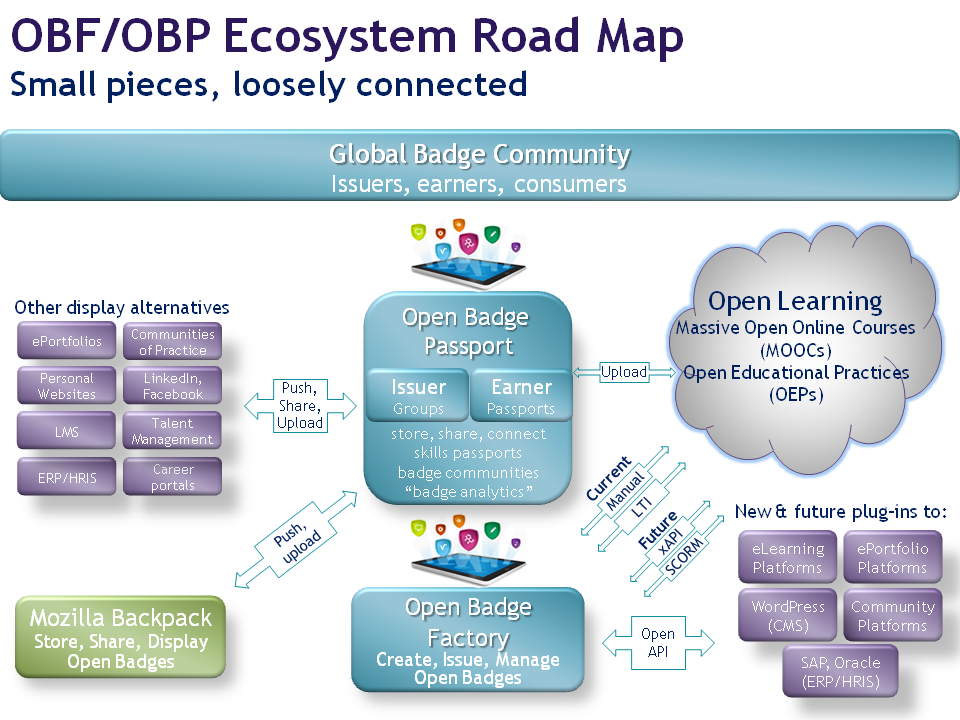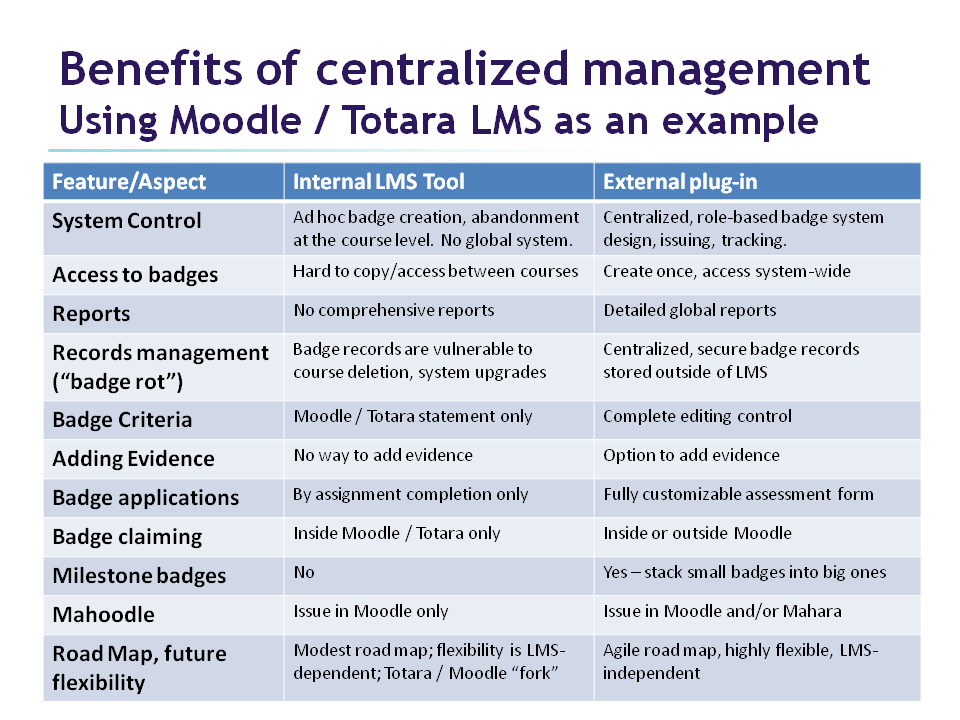I just heard that Discendum, the developers of my favourite eCredentialing solution, have joined the D2L Partner Network in order to develop a Brightspace LMS plugin for Open Badge Factory.

Brightspace has a huge footprint in Canada, so this pleases me no end. It actually pleases me more than last year’s news that Brightspace had introduced their own integrated badging solution, matching Moodle, Blackboard, and Canvas.
Why is that? Because your LMS may not be the best platform to run your Open Badge system.
Backstory
It took me a while to realize this. I’m actually partly responsible for Open Badges coming to Moodle: in late 2011, I connected Totara Learning to the DML competition and the “Moodle as Issuer, Mahara as Displayer” project was born. This brought Open Badges to Totara LMS and Moodle in 2013.*
But I’ve changed, largely from working with Eric Rousselle at Discendum over the past couple of years. (Full disclosure: Learning Agents is launching a Canadian eCredentialing service in early 2016 built on Open Badge Factory and Open Badge Passport technology.)
I love working with Discendum because I find them clear thinking, practical souls. They’re always concerned with finding value that customers will pay for and they look for the simplest technology paths to deliver that value. This is what’s made them the leading edtech provider in Finland (OK, it’s a small market. But still.)
And they know LMSs. They built their own (Optima), which is popular in Finland and they are Totara LMS partners, with clients in several countries. They’re also a Mahara ePortfolio Partner, with a large national multi-site Mahara similar to New Zealand’s MyPortfolio. ePortfolio is why we met at Serge Ravet’s ePIC 2012 conference, when Mozilla took Open Badges on tour in Europe and changed how we think about ePortfolios.
Eric was intrigued by the potential of Open Badges at ePIC and brought the notion back to Discendum in Finland. The Discendum team liked what it discovered in early experiments, but found the Open Badge community a bit anarchic back then. They decided there was a niche for them to fill: a non-US provider focused on the needs of learning organizations seeking to build trustable and sustainable badge systems, flexible enough to integrate with diverse workflows and demonstrate the quality of their learning.
Small pieces, loosely connected
What they’ve developed is a loosely coupled system that works *with* LMSs, but remains independent. Badges are triggered and displayed inside LMSs and other systems, but they’re created and managed inside the external badging platform. They’ve even decoupled issuers from earners, which will provide even more flexibility down the road:

From Open Badge Factory: A Badging Platform for Canada
Note: Salava, the open source Community Edition of Open Badge Passport, has recently been released on GitHub.
What are the benefits of this approach? Well, Discendum and I have developed this matrix comparison with an LMS-centric approach. It’s focused on Moodle and Totara LMS, because that’s what we know best. It’s propaganda, but sincere propaganda:
 From Open Badge Factory: A Badging Platform for Canada
From Open Badge Factory: A Badging Platform for Canada
We’re in good company
Discendum is not alone in this loosely coupled thinking, although they’ve taken it further than most. If you look at the Badge Alliance list of Badge Issuing Platforms and EduAppCenter’s open LTI app collection, you’ll see lots of flexible connectivity between LMSs and independent badging platforms.
Dan Hickey wrote a really interesting post last year about the increasing complexity of LMSs over time and how they tend to lose touch with their design origins as they keep on bolting on new features in response to customer demand. Phil Hill has labeled the LMS as the Minivan of Education (i.e. convenient, but stodgy and a bit embarrassing.) I think of them more as retro-fitted camper vans, bulging with awkward add-ons that sometimes leak at the seams.
Dan Hickey reported recently that he was meeting engineers at Instructure to “share the wish lists of ten Canvas users regarding badges, outcomes, and ePortfolios.” I do think Canvas is better equipped than many of its LMS competitors for continuing relevance due to its more modular, externally pluggable design. For example, Canvas already has LTI-based connectivity with Canvabadges, Acclaim, Badge Safe, Badger and Open Badge Factory.
Serge Ravet also wrote a great post about his frustrations in making Moodle LMS work together with Mahara ePortfolio to track competencies for a European project (he blames me for luring him into using Mahara). Serge suggested that Mahara ePortfolio have a badge issuer plugin for Open Badge Factory. Now it does. How flexible is that?
So here’s a top 3 summary of why you should think about housing your badge system *outside* the LMS:
- Specialized badge systems can focus on doing one thing well, away from the control of integrated omnibus applications
- Control and quality
– Trivial things can be badged (“great login, here’s a badge!”) and badge strategies can be scattered and fragmentary.
– Links inside badges start breaking as courses and accounts are deleted and even LMSs are migrated. This often means they’re no longer valid. (Badge rot is REAL, man…) - Flexibility!
And in conclusion…
So if you’re a learning organization (or a learning unit within one) and concerned about quality, here are some things for you to think about:
- Can I issue badges from my different systems and diverse workflows: face to face workshops, synchronous e-learning, within the LMS; and in other assessment and recognition contexts: ePortfolio, online community, testing applications…?
- How is evidence handled? Is it archived within the LMS, or exportable to a separate location?
- Where are the issued badges stored and how secure are they?
- What happens when we delete the course?
- What happens if we change our LMS?
- Can I control who creates and issues badges?
- Are the badges globally accessible and copyable within and across systems?
- Do I have a global picture of my badge system and can I track how well it’s achieving its goals?
On the other hand…
If it’s just about gamification within a course, then who cares? Fill your boots, as they say Down East in Canada. But think twice before you make these *Digital* Badges into *Open* Badges, i.e. portable into other contexts. Let’s be careful about handing out Open Badges like stickers, because that can degrade them as a skills currency.
* Footnote: reviewing at a HASTAC interview from that time makes me wonder what happened to the “Mahara as Displayer” part. Totara had ambitious plans to make Mahara part of a federated backpack system, but the only Mahara displayer I know of is made by Discendum.
Join us at the ePortfolio and Identity Conference ePIC 2016.
The Call for Contributions is now open:

